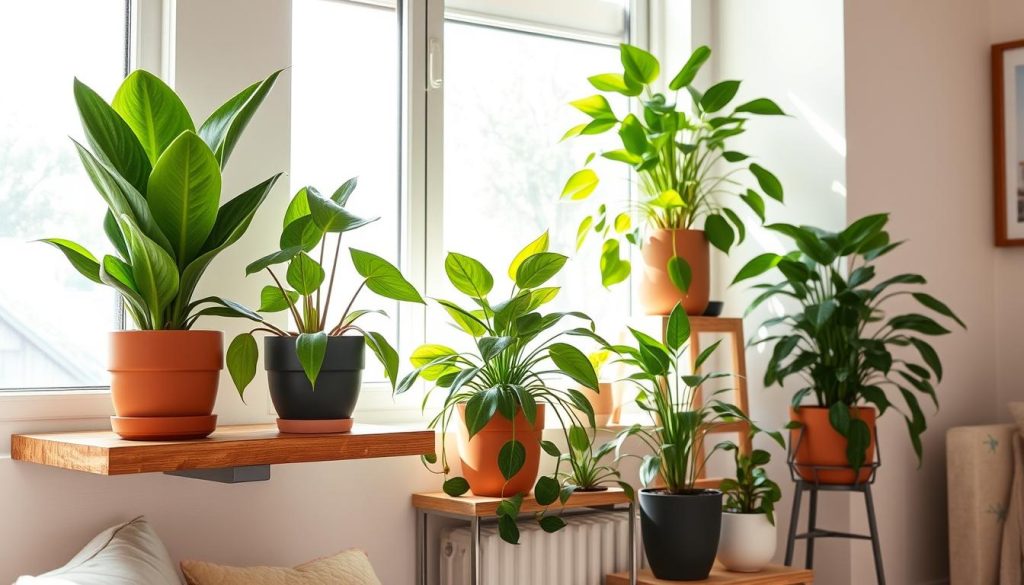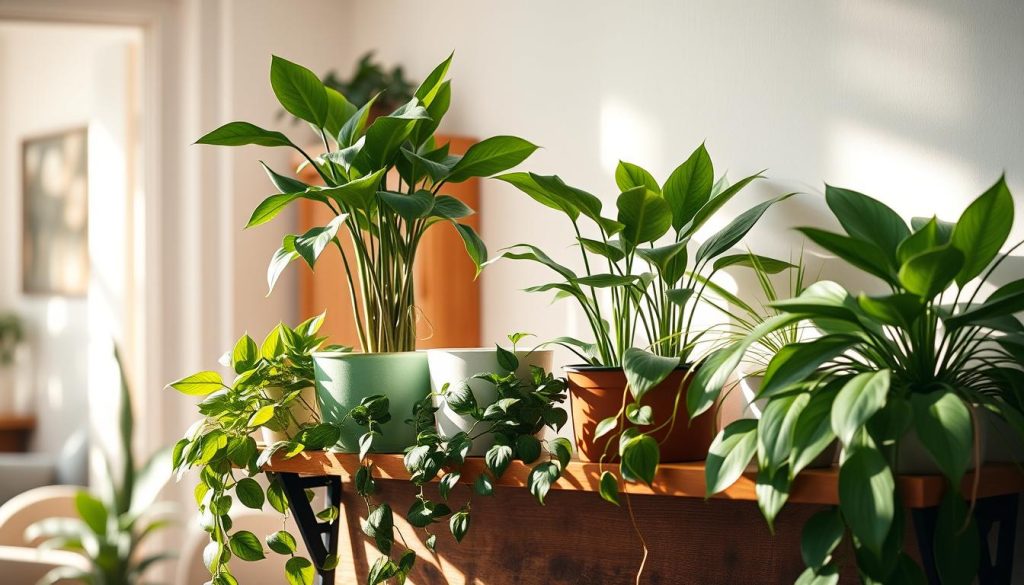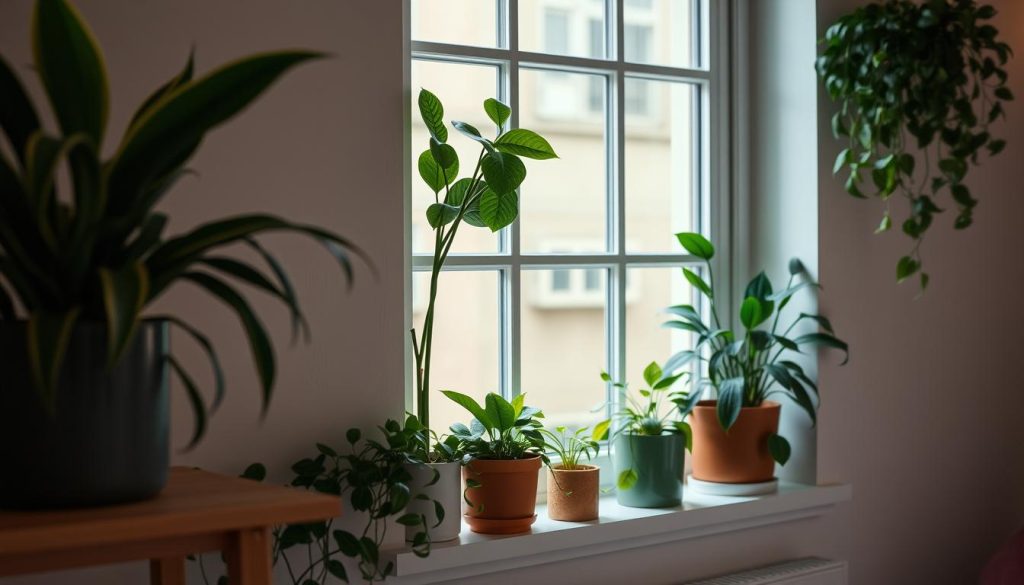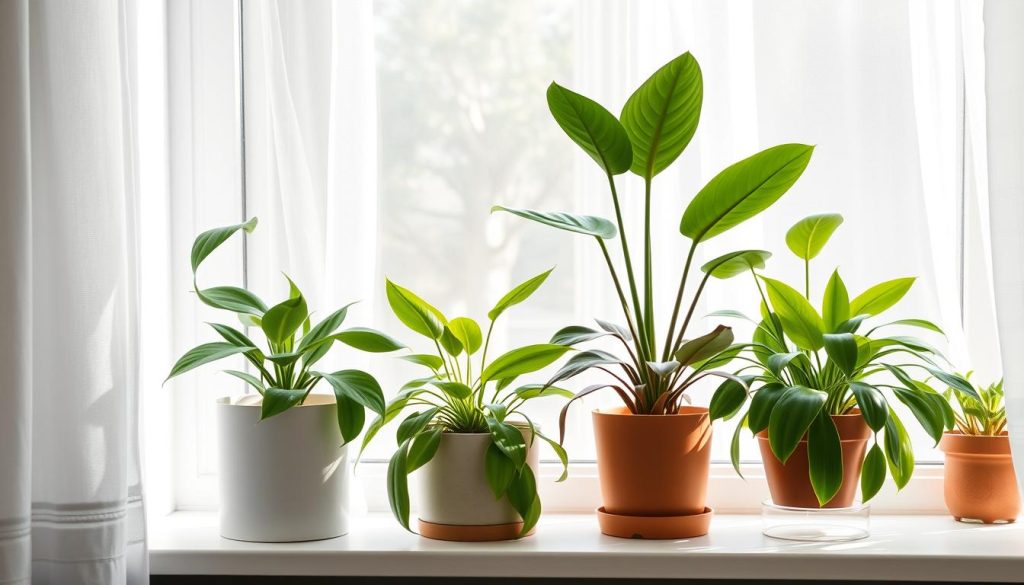I’m excited to share the best indoor plants for beginners. These plants can make your space better and improve your health. As a beginner, picking easy plants is key. They need little care.
Choosing the right indoor plants is important. I look for plants that are beautiful and easy to care for. Some top picks are low-maintenance plants that do well indoors. They bring effortless greenery to your home or office.
With the right plants, you can make a peaceful space. This space can help you feel better. We’ll show you how to pick and care for these plants.
Why Choose Indoor Plants?
Starting with indoor plants is a great idea. They clean the air and make your space look better. Plus, they bring calm and happiness into your home. It’s important to pick plants that are easy to care for and don’t need much work.
Some of the benefits of indoor plants include:
- Improved air quality: Indoor plants clean the air, making it healthier.
- Stress reduction: Plants help lower stress and anxiety, making you feel calm.
- Low maintenance: Many plants need only occasional watering and pruning.

Benefits of Indoor Plants
Indoor plants do more than just look good. They improve air quality and boost mental health. By picking the right plants, you can make your home a peaceful and healthy place.
How Plants Improve Indoor Air Quality
Indoor plants act as natural air purifiers. They remove harmful toxins and pollutants. This is great for people who spend a lot of time indoors, as it can help prevent respiratory problems and other health issues.
Mental Health Boost from Indoor Greenery
Being around plants can really help your mental health. It can lower stress and anxiety, and make you feel more calm and happy. If you want to improve your mood or create a peaceful space, indoor plants are a great choice.
Low-Maintenance Plants for Beginners
Choosing the right plants for your indoor space can be tough. There are many options, but it’s best to pick plants that are easy to care for. These plants should be able to grow well in different conditions.
Some of the best indoor plants for beginners are those that don’t need much care. They’re great for people who are busy or new to taking care of plants. Here are a few examples:
- Snake Plant: known for its ability to purify the air and thrive in low-light conditions
- Pothos: a versatile and adaptable plant that can grow in a variety of lighting conditions
- ZZ Plant: a low-maintenance plant that can survive with infrequent watering and low light
These plants are not only easy to care for, but they also add greenery to your space. They’re a perfect choice for beginners. By picking the right plants, you can enjoy indoor gardening without the stress of caring for high-maintenance plants.

With these low-maintenance plants, you can start your indoor gardening journey with confidence. Choose plants that fit your lifestyle and provide the right conditions for them to thrive. Happy planting!
Best Indoor Plants for Low Light
Finding the right indoor plants for low-light spaces can be tough for beginners. But, there are many plants that do well in these conditions. We’ll look at three plants that can brighten up any room, even with little light.
Heartleaf Philodendron: A Low-Maintenance Option
The heartleaf philodendron is a favorite for beginners. It’s easy to care for and grows well in low light. It’s perfect for those new to indoor gardening.
Cast Iron Plant: Tough and Tolerant
The cast iron plant is great for low-light areas. It can handle low light and doesn’t need much water. It’s ideal for busy people or those new to indoor plants.
Peace Lily: Beautiful Blooms in Dim Spaces
The peace lily thrives in low light and adds elegance with its white blooms. It’s a stunning choice for indoor spaces. With the right care, it can be a beautiful addition to any room.
These plants are great for beginners and can make any room beautiful. Whether you want something easy to care for or a plant that can handle low light, there’s a perfect choice for you.

| Plant | Lighting Requirements | Watering Needs |
|---|---|---|
| Heartleaf Philodendron | Low to medium light | Water thoroughly, allowing soil to dry slightly between waterings |
| Cast Iron Plant | Low light | Water sparingly, allowing soil to dry completely between waterings |
| Peace Lily | Low to medium light | Water thoroughly, allowing soil to dry slightly between waterings |
Popular Indoor Plants for Beginners
Choosing the right indoor plants is key for beginners. Look for plants that are easy to care for and can grow well in different conditions. The spider plant, dracaena, and rubber plant are great choices. They are stylish and don’t need much care, making them perfect for new gardeners.
Spider Plant: A Classic Favorite
The spider plant is a favorite among indoor plant lovers. It’s easy to care for and can be easily shared with friends. Its long stems and leaves make it a beautiful addition to any room.
Dracaena: Stylish and Low-Maintenance
Dracaena is a stylish, low-maintenance plant that can grow up to 10 feet tall. It’s ideal for beginners who want to add elegance without much effort. With over 40 species, you’re sure to find one that matches your style.
Rubber Plant: Striking Leaves and Air Purifying
The rubber plant is known for its striking leaves and air-purifying qualities. It’s a great choice for beginners who want to purify the air and add greenery. With proper care, it can grow up to 8 feet tall, becoming a beautiful focal point.
These plants are perfect for beginners who want to add greenery to their space. They are easy to care for and can thrive in different conditions. Whether you choose the spider plant, dracaena, or rubber plant, you’ll enjoy the benefits of indoor gardening.

| Plant | Lighting Requirements | Watering Needs |
|---|---|---|
| Spider Plant | Medium to bright light | Water thoroughly, allowing soil to dry between waterings |
| Dracaena | Low to medium light | Water sparingly, allowing soil to dry completely between waterings |
| Rubber Plant | Bright, indirect light | Water thoroughly, allowing soil to dry slightly between waterings |
How to Care for Your Indoor Plants
Caring for your indoor plants can seem tough at first. But, with the right tips, you can keep them happy and healthy. It’s important to care for them well to make sure they thrive.
Watering Tips for Beginners
Watering is key in plant care. Too much water can harm your plants. So, it’s vital to get it right. Here are some tips for watering your plants:
- Check the soil moisture by sticking your finger into the soil up to the first knuckle.
- Water your plants when the soil feels dry to the touch.
- Avoid getting water on the leaves to prevent fungal diseases.
Understanding Light Requirements
Light is also very important. Most indoor plants like bright, indirect light. But, some can handle low light. Knowing what your plants need will help you place them right.
Choosing the Right Pot for Your Plants
Starting with indoor plants can be exciting but picking the right pot can be tough. There are many materials and styles out there. It’s key to think about what your plants need. The right pot can help your plants grow well.
There are different materials for pots like ceramic, terracotta, and plastic. Each has its own good points and downsides. Ceramic pots look nice and keep soil temperature right. Terracotta pots drain well and are good for the planet.
Pot Material and Drainage Matters
Drainage is very important when picking a pot. Your plants need soil that drains well to avoid root rot. Look for pots with holes or add rocks to help with drainage.
Sizing and Aesthetic Considerations
The size and look of the pot matter too. Pick a pot that fits your plant and lets it grow. Think about the pot’s color and style to match your space.
Think about the pot’s material, drainage, size, and style. This will help your plants thrive. Choose a pot that fits your plants’ needs. Don’t be afraid to try different pots to find the best one.
| Pot Material | Benefits | Drawbacks |
|---|---|---|
| Ceramic | Aesthetically pleasing, regulates soil temperature | Can be heavy, expensive |
| Terracotta | Excellent drainage, eco-friendly | Can be fragile, prone to cracking |
| Plastic | Lightweight, affordable | Can be flimsy, may not provide adequate drainage |
Indoor Plants That Flourish in Humid Environments
Creating a lush home atmosphere is easy with plants that love humidity. As a beginner, picking the right plants is key. The Boston fern and orchid are great choices. They’re easy to care for and add elegance to any room.
These plants offer many benefits:
- Purifying the air and improving indoor air quality
- Adding a touch of natural beauty to your space
- Creating a calming and peaceful atmosphere
Boston Fern: Adds Lushness to Any Room
The Boston fern is a favorite among plant lovers. It’s easy to care for and works well in different light conditions. Its lush green fronds bring a tropical vibe to any room.
Orchid: Elegance Meets Care
Orchids are stunning and delicate, perfect for adding sophistication. They’re easy to care for and love humid places. This makes them ideal for bathrooms or kitchens.
Decorating with Indoor Plants
Decorating with indoor plants is fun and creative. You can add personality and style to any room. Choose plants that are easy to care for and can thrive in different conditions.
Decorating with indoor plants opens up endless possibilities. You can make a green corner, enhance your décor, or create a beautiful plant arrangement. Here are some tips to get you started:
Creating a Green Corner
- Choose a spot with plenty of natural light
- Select a variety of plants with different textures and colors
- Add a decorative planter or pot to complete the look
Using Plants to Enhance Your Décor
Plants can add elegance and sophistication to any room. Use plants with beautiful blooms or unique foliage to create a stunning display.
Practical Tips for Plant Arrangement
| Plant | Lighting Requirements | Care Tips |
|---|---|---|
| Snake Plant | Low to medium light | Water sparingly, fertilize monthly |
| Pothos | Medium to bright light | Water regularly, prune often |
Follow these tips and choose the right plants. You can create a beautiful and thriving indoor garden. It will bring joy and serenity to your home.
Troubleshooting Common Plant Problems
Starting with low maintenance indoor plants can be tricky. But, knowing how to fix common issues can help. This way, your plants will do well.
Issues like overwatering, pests, and nutrient gaps are common. Spotting these problems early and acting fast is key.
Recognizing Overwatering Symptoms
Overwatering can harm your plants. Look out for yellow leaves, droopy stems, and soggy soil. Always check the soil moisture before watering.
Identifying Pests
Pests like spider mites, mealybugs, and aphids can trouble indoor plants. Regular checks can help spot pests. Look for white patches or sticky leaves.
Fixing Nutrient Deficiencies
Nutrient gaps can lead to yellow leaves, slow growth, and fewer flowers. A balanced fertilizer can help. It gives your plants the nutrients they need.
By following these tips, you can solve common plant problems. Keep an eye on your plants and ask for help if needed.
Here are some extra tips:
- Water your plants carefully, avoiding overwatering
- Provide enough light and nutrients for your plants
- Regularly check your plants for pests or diseases
| Common Plant Problems | Solutions |
|---|---|
| Overwatering | Check soil moisture before watering |
| Pest infestations | Inspect plants regularly, use insecticidal soap |
| Nutrient deficiencies | Use balanced fertilizer, provide essential nutrients |
Seasonal Care for Indoor Plants
As a beginner, it’s key to know that indoor plants need seasonal care. They can be sensitive to temperature, humidity, and light changes. So, adjusting their care all year is important.
With a bit of planning and care, even the simplest plants can thrive. Let’s look at how to adjust care and prepare plants for winter.
Adjusting Care Throughout the Year
Here are some tips for adjusting care:
- Watering: Reduce watering in winter and increase in summer
- Lighting: Move plants to brighter locations in winter and shadier spots in summer
- Fertilization: Fertilize plants during the growing season (spring and summer)
Preparing Your Plants for Winter
To prepare your plants for winter, make sure to:
- Bring plants indoors before the first frost
- Reduce watering and fertilization
- Prune plants to maintain shape and promote healthy growth
Resources for New Plant Parents
Starting your journey as a plant parent is exciting. There are many resources to help you grow your indoor garden with confidence. You can find expert advice, inspiration, and a supportive community.
Recommended Books and Websites
For beginners, I suggest checking out “The Plant Lover’s Guide to Growing Houseplants” by Danae Horst or “How Not to Kill Your Houseplant” by Veronica Peerless. These books offer detailed guides on choosing, caring for, and fixing commonbeginner houseplants. Online, sites like Plantiful and The Spruce have lots of articles and tips forbest beginner indoor plants.
Online Communities and Forums
Online communities and forums are a big help for new plant parents. Groups like the r/houseplants subreddit on Reddit or the Houseplant Hobbyists Facebook group are great. You can ask questions, share your successes, and learn from others.
Local Gardening Centers: A Treasure Trove
Don’t overlook your local gardening center or nursery. The staff there can give you personalized advice on choosing the right plants. You’ll also find a wide selection ofbeginner houseplantsand get hands-on care tips.

